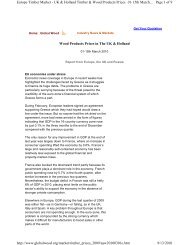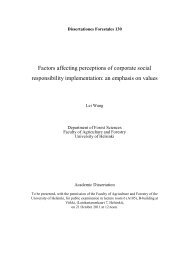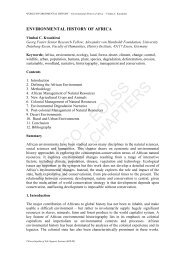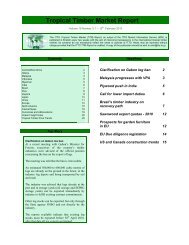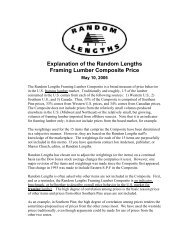ICT and e-Business in the Pulp, Paper and Paper ... - empirica
ICT and e-Business in the Pulp, Paper and Paper ... - empirica
ICT and e-Business in the Pulp, Paper and Paper ... - empirica
You also want an ePaper? Increase the reach of your titles
YUMPU automatically turns print PDFs into web optimized ePapers that Google loves.
<strong>Pulp</strong>, paper <strong>and</strong> paper products<br />
3.7 <strong>ICT</strong> <strong>and</strong> Innovation<br />
The capability for <strong>in</strong>novation is considered quite important by European companies <strong>in</strong><br />
<strong>the</strong> P&P <strong>in</strong>dustry <strong>in</strong> order to face global competition <strong>and</strong> to keep <strong>the</strong>ir position <strong>in</strong> higher<br />
market segments, which rely on differentiation <strong>and</strong> quality. It is largely recognised that<br />
both product <strong>and</strong> process <strong>in</strong>novation (e.g. automation, flexible re-organisation) are key<br />
<strong>in</strong>struments to support this strategy. This can only be achieved by a large-scale<br />
deployment of lead<strong>in</strong>g-edge research results, a highly efficient process organisation <strong>and</strong><br />
cha<strong>in</strong> management, <strong>and</strong> a highly qualified work-force.<br />
This competitive scenario pushes companies towards <strong>the</strong> usage of technologies to<br />
<strong>in</strong>novate products, to enhance quality <strong>and</strong> broaden applicability of materials. Process<br />
<strong>in</strong>novation is centred on production processes, such as automated <strong>and</strong> computer-based<br />
manufactur<strong>in</strong>g systems, or processes aimed at manufactur<strong>in</strong>g products that can comb<strong>in</strong>e<br />
costs of mass production with differentiation of customised, optimisation of <strong>the</strong> value<br />
cha<strong>in</strong>.<br />
In this context, e-<strong>Bus<strong>in</strong>ess</strong> W@tch asked companies whe<strong>the</strong>r <strong>the</strong>y had launched any new<br />
or substantially improved products or services dur<strong>in</strong>g <strong>the</strong> 12 months prior to <strong>the</strong> <strong>in</strong>terview,<br />
<strong>and</strong> if <strong>the</strong>y had <strong>in</strong>troduced new or significantly improved <strong>in</strong>ternal processes <strong>in</strong> <strong>the</strong> same<br />
period of time. Companies that <strong>in</strong>dicated that <strong>the</strong>y have <strong>in</strong>troduced <strong>in</strong>novations were <strong>the</strong>n<br />
asked follow-up questions on <strong>the</strong> role of <strong>ICT</strong> for <strong>the</strong>ir <strong>in</strong>novation activity.<br />
About 30% of enterprises <strong>in</strong> <strong>the</strong> P&P <strong>in</strong>dustry said that <strong>the</strong>y had launched new (or<br />
improved) products <strong>in</strong> 2005/06. About a third of <strong>the</strong>se product <strong>in</strong>novations had been<br />
directly related to or enabled by <strong>ICT</strong> (see Exhibit 3-35). Thus, <strong>the</strong> <strong>in</strong>cidence of product<br />
<strong>in</strong>novation is slightly higher than on average <strong>in</strong> <strong>the</strong> 10 sectors studied this year by e-<br />
<strong>Bus<strong>in</strong>ess</strong> W@tch, but <strong>the</strong> share of <strong>ICT</strong>-enabled product <strong>in</strong>novations is relatively lower<br />
(45-50% on average). This is plausible, as <strong>ICT</strong> is of course more important for products <strong>in</strong><br />
<strong>ICT</strong>-related sectors. However, even <strong>the</strong> share of about a third of all <strong>in</strong>novations be<strong>in</strong>g<br />
<strong>ICT</strong>-enabled is considerable <strong>and</strong> demonstrates <strong>the</strong> important role of <strong>ICT</strong> for<br />
manufactur<strong>in</strong>g purposes.<br />
A similar picture can be found for process <strong>in</strong>novations. While <strong>the</strong> overall propensity<br />
towards <strong>in</strong>novation is above average <strong>in</strong> <strong>the</strong> P&P <strong>in</strong>dustry, survey f<strong>in</strong>d<strong>in</strong>gs <strong>in</strong>dicate a<br />
higher share of non-<strong>ICT</strong> related <strong>in</strong>novations <strong>in</strong> this <strong>in</strong>dustry than <strong>in</strong> many o<strong>the</strong>r sectors. In<br />
total, companies represent<strong>in</strong>g about 45% of employment <strong>in</strong> <strong>the</strong> P&P <strong>in</strong>dustry said that<br />
<strong>the</strong>y had <strong>in</strong>troduced process <strong>in</strong>novations <strong>in</strong> <strong>the</strong> 12 months prior to <strong>the</strong> <strong>in</strong>terview. More<br />
than half of <strong>the</strong>se <strong>in</strong>novations are regarded as <strong>ICT</strong>-enabled. Among larger firms, <strong>the</strong> role<br />
of <strong>ICT</strong> for process <strong>in</strong>novation <strong>in</strong>creases; about two thirds of all process <strong>in</strong>novations<br />
among medium-sized <strong>and</strong> large companies are <strong>ICT</strong>-enabled.<br />
79



